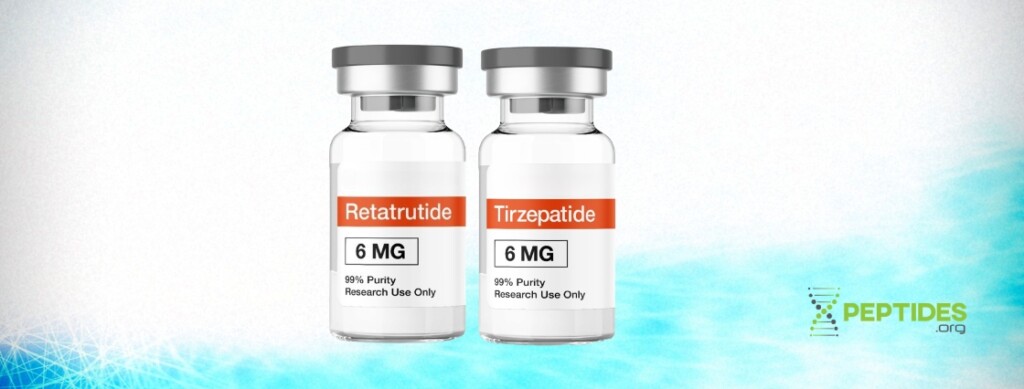Professionals seeking an in-depth comparison of retatrutide vs. tirzepatide for weight loss research may find this guide valuable for their academic or scientific endeavors.
Retatrutide and tirzepatide are two novel incretin mimetics with shared benefits for clinical research, including:
- Weight management
- Glycemic control
- Cardiovascular health
Retatrutide is a triple-hormone-receptor agonist currently being explored as a potential treatment for weight loss. In contrast, tirzepatide is the first dual-incretin mimetic peptide to be approved for the treatment of type 2 diabetes and chronic weight management.
In this guide, our expert team provides a comprehensive comparison between retatrutide and tirzepatide, helping researchers decide which peptide to prioritize in their further studies.
Buy research peptides from a top-rated vendor today...

Disclaimer: Peptides.org contains information about products that are intended for laboratory and research use only, unless otherwise explicitly stated. This information, including any referenced scientific or clinical research, is made available for educational purposes only. Likewise, any published information relative to the dosing and administration of reference materials is made available strictly for reference and shall not be construed to encourage the self-administration or any human use of said reference materials. Peptides.org makes every effort to ensure that any information it shares complies with national and international standards for clinical trial information and is committed to the timely disclosure of the design and results of all interventional clinical studies for innovative treatments publicly available or that may be made available. However, research is not considered conclusive. Peptides.org makes no claims that any products referenced can cure, treat or prevent any conditions, including any conditions referenced on its website or in print materials.
What is Tirzepatide?
Tirzepatide (LY3298176) is a first-in-class dual GIP/GLP-1 receptor agonist developed by Eli Lilly and Company and patented in 2016.
This 39-amino-acid peptide leverages the functions of two endogenous hormones: glucose-dependent insulinotropic polypeptide (GIP) and glucagon-like peptide-1 (GLP-1) [1].
These hormones are produced by endocrine cells in the gastrointestinal tract and stimulate insulin production following food intake, while also suppressing appetite [2].
Here is what researchers should know about tirzepatide:
- Tirzepatide has a structure based on GIP at its N-terminus and a portion derived from the GLP-1 receptor agonist exenatide at the C-terminus. This mediates its dual agonism with a bias towards GIP receptors [3].
- The peptide has a hydrophilic linker and a C20 fatty di-acid component. Together with other modifications in the peptide sequence, this leads to a tirzepatide half-life of over five days [1, 4].
- Tirzepatide activates GIP and GLP-1 receptors in the exocrine pancreas, promoting a reduction in blood glucose levels and aiding in the management of type 2 diabetes (T2D) [1].
- The effectiveness of tirzepatide in T2D was confirmed by the phase 3 trials of the SURPASS clinical development program. Following the program’s success, tirzepatide was approved by the United States Food and Drug Administration (FDA) in 2022 as a treatment for T2D, at doses up to 15mg/weekly under the brand name Mounjaro [1, 5].
- By triggering GLP-1 and GIP receptors in other tissues, tirzepatide also slows down digestion and suppresses appetite, helping patients achieve significant weight reduction [6, 7, 8].
- Tirzepatide’s weight loss potential was proved in the SURMOUNT clinical program, which consisted of several phase 3 trials. This led to its approval for weight loss in non-diabetics in 2023. The peptide is marketed as Zepbound for this indication and is dosed at 15mg/weekly [5].
Eli Lilly is also conducting a phase-3 trial called SURPASS-CVOT, which explores the potential benefits of tirzepatide for cardiovascular health in T2D patients [9].

What is Retatrutide?
Retatrutide (LY3437943) is a novel incretin mimetic also created by Eli Lilly and studied for its potential in weight loss [10, 11]. It is a triple-hormone-receptor agonist that, similar to tirzepatide, simulates the GLP-1 and GIP receptors. In addition, retatrutide also activates the glucagon (GCG) receptors [12, 13].
Here is what researchers should know about retatrutide:
- Retatrutide consists of 39 amino acids, with a structure deriving from the incretin hormone GIP. The peptide was designed to also activate GLP-1 and GCG receptors, with a bias towards GIP receptors [14].
- Similar to tirzepatide, retatrutide’s activation of GLP-1 and GIP receptors promotes insulin secretion, decelerates digestion, and reduces appetite, contributing to notable weight loss [6, 7, 8].
- Retatrutide’s stimulation of GCG receptors is believed to enhance metabolic rate and boost energy expenditure, further facilitating weight loss [15].
- Retatrutide incorporates a fatty acid modification to enhance its stability and extend its half-life to six days, enabling weekly dosing [16].
While yet to be authorized for human use by regulatory authorities such as the FDA, retatrutide is currently in phase 3 clinical trials under Eli Lilly’s TRIUMPH development program.
It is being studied for its potential to improve glycemic control and assist in weight management in individuals with and without T2D, at a maximum dose of 12mg/weekly [11].

Retatrutide vs. Tirzepatide | Comparing Benefits and Research Applications
Retatrutide and tirzepatide have similar uses and effects, such as improving blood sugar control and aiding in weight reduction.
As of writing, retatrutide has yet to obtain regulatory authorization for medical use. Nevertheless, the peptide is under active research in phase 3 trials, and initial studies suggest that retatrutide could be as effective as tirzepatide in weight loss settings.
The following sections provide a comprehensive comparison of the unique characteristics of both peptides.
Retatrutide vs. Tirzepatide for Weight Loss Research?
As mentioned, both retatrutide and tirzepatide are potent weight loss peptides that suppress appetite. They work by targeting the GIP and GLP-1 receptors in the brain's appetite control centers, including the hypothalamus [17, 18].
Retatrutide may achieve superior weight loss compared to tirzepatide by influencing both calorie intake and calorie burning. This is because the triple receptor agonist also activates GCG receptors in the liver and fat tissue, potentially enhancing fat breakdown in liver cells and the transformation of white fat to beige fat, which increases heat-generated energy expenditure [15].
Unfortunately, there are currently no direct comparative studies involving both retatrutide and tirzepatide in terms of their weight loss effectiveness.
Yet, existing clinical data confirm the beneficial effects of both peptides. Here are some of the most notable findings to date:
- The weight loss effectiveness of tirzepatide has been investigated in four phase 3 trials as part of the SURMOUNT program. The largest of these trials (SURMOUNT-1) included over 2500 participants who experienced a mean weight loss of roughly 21% from baseline after 72 weeks at 15mg/weekly [19].
The longest of the trials (SURMOUNT-4) reported weight loss of -20.9% within 36 weeks and an additional -5.5% (total of -25.4%) within 88 weeks of administration [20].
- In a 48-week phase 2 study of retatrutide involving 338 overweight or obese non-diabetic participants, researchers observed dose-dependent decreases in weight and improvements in waist circumference, blood pressure, levels of glycated hemoglobin, fasting glucose and insulin, and most lipid metrics.
- The group receiving the highest retatrutide dose of 12mg/weekly experienced a significant 24.2% reduction in weight, compared to a modest 2.1% reduction in the placebo group [21].
As evident, both tirzepatide and retatrutide can induce significant weight loss within the range of 24-25% from baseline after 48-88 weeks of therapy.
However, future retatrutide trials of longer duration and greater sample sizes may show even greater weight loss effectiveness compared to tirzepatide. Therefore, more data is needed to determine whether tirzepatide or retatrutide is the more potent weight loss agent.
Retatrutide vs. Tirzepatide for Type 2 Diabetes Research?
Both retatrutide and tirzepatide have been studied for their ability to improve glycemic control in T2D, with a focus on the reduction of glycated hemoglobin (HbA1c), a key indicator of long-term glycemic management.
Of the two, tirzepatide holds FDA approval for use in T2D patients, while retatrutide is already in phase 3 trials for the same indication [22].
To date, no direct comparisons between the two peptides exist, leaving us to rely only on available data from their respective clinical trials.
- Results from the SURPASS program's phase 3 trials indicate that tirzepatide, administered weekly in doses of 5mg, 10mg, and 15mg, significantly enhances glycemic control in T2D. It reduces HbA1c by an average of 2.3%-2.4% from baseline, reaching up to 2.58% in certain studies of 40-52 weeks in duration. These results demonstrate superior performance compared to other GLP-1 agonists, insulin, and placebo [23, 24, 25, 26].
- In a separate 36-week phase 2 trial in 281 T2D patients treated with up to 12mg retatrutide weekly, researchers observed significant reductions in HbA1c. By the 24-week mark, levels decreased by 2.02% (22.07 mmol/mol), and by 2.16% (23.59 mmol/mol) at 36 weeks, compared to no significant changes in the control group. This study also highlighted a dose-dependent weight loss of up to 17%, significantly higher than the 3% loss observed with placebo [27].
Overall, the research suggests that both retatrutide and tirzepatide are highly effective at lowering HbA1c levels. Tirzepatide appears to have a greater effect on glycemic control but retatrutide trials are still limited.
More extensive clinical trials are needed to shed more light on the effectiveness of retatrutide for T2D, and whether it may be limited due to the activation of the GCG receptors, which may exert anti-insulin effects.
Retatrutide vs. Tirzepatide for Cardiovascular Health
Both retatrutide and tirzepatide are currently in phase 3 trials for their potential in reducing the risk of cardiovascular problems in patients with T2D or obesity.
Analysis of the available research reports that tirzepatide administered at 15mg/weekly may result in a hazard ratio (HR) of 0.8 for the incidence of cardiovascular events.
This statistical metric can be interpreted as a 20% reduction in the risk of such events, and the reduction appears significantly lower, compared to placebo (HR=0.9) [28].
Further data on the effects of tirzepatide on cardiovascular risk will be elucidated in the phase 3 SURPASS-CVOT trials [9].
Similarly, the phase 3 TRIUMPH-3 trial is recruiting patients struggling with overweight or obesity and who also have a history of cardiovascular disease. This trial aims to investigate whether retatrutide may positively impact cardiovascular health and reduce the risk of events [29].
Retatrutide and Tirzepatide | Dosage Comparison | Research Only
Retatrutide and tirzepatide have similar dosing schedules due to their related pharmacokinetic properties. Both peptides have a half-life of about 5-6 days [1, 21].
Below, we outline sample dosing schedules as described in the available scientific publications. Such dosing recommendations are for research use only.
Tirzepatide Dose for Weight Loss
Researchers are advised to start incretin mimetics like tirzepatide at a minimal dose and increase it gradually. This strategy effectively reduces the incidence of side effects, particularly gastrointestinal issues.
The administration of tirzepatide typically starts at 2.5mg/weekly. This dosage is increased by 2.5mg every four weeks until a maximum of 15mg/weekly is reached [23].
In weight loss studies, non-diabetic participants had similar outcomes between the 10mg and 15mg/weekly doses of tirzepatide. Therefore, it is advisable that weight loss researchers increase the dose from 10mg/weekly based on both tolerance and effectiveness [30].
Below is a detailed tirzepatide dosing schedule based on recent studies:
- Tirzepatide Dose: Initiate at 2.5mg/weekly for the first four weeks, raise to 5mg for weeks 5 to 8, then to 7.5mg for weeks 9 to 12, and 10mg for weeks 13 to 16. Depending on the response, the dose may be increased to 12.5mg for weeks 17 to 20, and then to 15mg starting from week 21.
- Administration: Tirzepatide should be administered once weekly via subcutaneous injection at consistent times.
- Duration of Study: Tirzepatide study duration has varied from 24 to 72 weeks.
- Notes: The weekly dose of 15mg should not be exceeded. If a dose is missed, it must be administered within five days or omitted entirely; subsequent doses should continue as scheduled.
Retatrutide Dose for Weight Loss
When initiating research protocols for retatrutide, it is advisable to start with a minimal dose of 1mg/weekly. Over the course of the study, this amount may be incrementally increased to minimize potential side effects, culminating in a maximum recommended dose of 12mg/weekly.
Retatrutide's extended half-life renders it ideal for weekly subcutaneous injections, which may be administered at any time regardless of diet or lifestyle.
Previous research studies involving retatrutide have spanned up to 48 weeks. In these studies, the safety profile of retatrutide was found to be on par with that of other incretin mimetics like tirzepatide [21, 27].
Below is a comprehensive dosing regimen derived from existing research:
- Retatrutide Dose: Initiate at 1mg/weekly for the first four weeks, before raising to 2mg/weekly for weeks 5 to 8, 4mg for weeks 9 to 12, 8mg for weeks 13 and 16, before finally reaching 12mg from the 17th week onwards.
- Administration: Administer weekly via subcutaneous injection.
- Duration of Study: Research studies have lasted up to 48 weeks.
- Notes: Dosing adjustments may be needed depending on the subject’s response, without exceeding the dose of 12mg/weekly. If a dose is missed, it should be administered within five days or otherwise omitted. Subsequent doses should adhere strictly to the scheduled timeline.
Retatrutide and Tirzepatide | Side Effects and Safety
Research into tirzepatide and retatrutide has yielded substantial insights into their potential side effects, with gastrointestinal issues being the most frequently reported across studies.
A meta-analysis incorporating data from ten tirzepatide studies and involving over 6,800 participants found that tirzepatide at 15mg/weekly resulted in a 10% discontinuation rate due to adverse effects.
The side effects observed were [31]:
- Nausea (24% of participants)
- Diarrhea (21%)
- Vomiting (14%)
- Constipation (8%)
- Dyspepsia (7%)
- Injection site reactions (3%)
- Cholelithiasis (less than 1%)
- Pancreatitis (less than 1%)
Gastrointestinal side effects were the most common reason for discontinuation and their severity varied from mild to moderate. Additionally, hypersensitivity reactions occurred in approximately 2-4% of participants.
The largest phase 2 study published on retatrutide, which included 338 non-diabetics, indicated comparable side effects. Reported incidences in those receiving a 12mg/weekly dose of retatrutide were [21]:
- Nausea (45% of participants)
- Vomiting (19%)
- Constipation (16%)
- Diarrhea (15%)
- Cardiac arrhythmia (11%)
- Fatigue (10%)
- Increased pancreatic enzyme (lipase) levels (8%)
- Injection site reactions (8%)
- Liver issues in 2 participants (3%)
- Pancreatitis in 1 participant (2%)
Both tirzepatide and retatrutide share similar contraindications, including advice against their use during pregnancy and breastfeeding. Although animal studies hint at a potential risk of thyroid cancer from these peptides, there is no human data confirming the risk.
Overall, both peptides exhibit favorable safety profiles and similar adverse effects and contraindications. The likelihood of experiencing adverse reactions generally increases at higher doses of these compounds.
More trials are needed to fully elucidate the safety of the novel triple-receptor-agonist retatrutide.

Where to Buy Weight Loss Peptides Online? | 2024 Edition
Researchers interested in procuring retatrutide or tirzepatide should prioritize purchasing from a reputable supplier.
It is not advisable to buy from an online vendor who does not offer guarantees of quality, as its products may not meet purity standards.
Further, it is also essential for researchers to comply with the applicable legal and regulatory requirements concerning the procurement, use, and disposal of retatrutide and tirzepatide.
Considering the aforementioned, we highly recommend the following two sources for acquiring research-grade tirzepatide and retatrutide.
Xcel Peptides
Xcel Peptides is a relatively new player in the market, offering research-grade retatrutide at competitive prices. They provide several advantages, including:
- Lab-Tested Compounds: Xcel Peptides ensures that each batch of retatrutide is thoroughly tested by Janoshik Analytical laboratories. Detailed test results and Certificates of Analysis are available on their website.
- Efficient Checkout Process: The company offers an easy purchasing process with various payment methods such as credit cards, Zelle, Venmo, and Cash App.
- Proactive Customer Support: Xcel Peptides' customer service is responsive and can be reached via email during business hours.
Buy research peptides from Polaris Peptides today...

Limitless Biotech
Based in Florida, Limitless Biotech specializes in high-quality research chemicals, including peptides for weight loss. Researchers can click the link above to join the company’s VIP club, which offers exclusive access to tirzepatide and retatrutide.
Here’s what researchers can expect when ordering peptides from this esteemed provider:
- USA-Made Peptides: Limitless Biotech sources its peptides from certified US laboratories, ensuring that they adhere to industry standards.
- Dedicated Customer Service: The company is committed to customer satisfaction and addresses any issues with orders swiftly.
- Free U.S. Shipping: Limitless Biotech offers free domestic shipping for orders over $350, with most orders shipped on the same day the payment is received.
Buy research peptides from GOLDEN Peptides today...

Retatrutide vs. Tirzepatide | Verdict
Both retatrutide and tirzepatide are recently developed peptides with significant weight loss capabilities.
These compounds share similar pharmacokinetics and safety profiles, while effectively improving glycemic control and potentially offering additional benefits for cardiovascular health.
While tirzepatide is already approved for the treatment of T2D and chronic weight management, retatrutide is still under investigation in phase 3 clinical trials.
According to existing research, both peptides may have similar effectiveness in terms of weight management effectiveness in diabetics and nondiabetics, with retatrutide holding a slight edge.
Future trials are expected to showcase an even greater weight loss effectiveness for retatrutide due to its unique triple-agonist mechanisms.
Researchers interested in acquiring retatrutide or tirzepatide for investigative purposes are advised to visit our most trusted suppliers of reference materials.
